How to grow begonia from seeds at home?
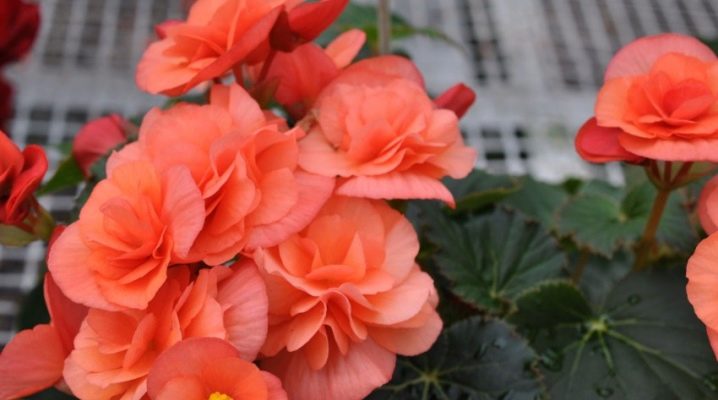
Plant propagation is a question that is always interesting to any grower. In order to properly grow flowers at home, you need to clearly know the main rules and principles of transplantation and reproduction. In this article, we'll talk about how to grow such an interesting and popular flower in horticultural circles like begonia from seeds.

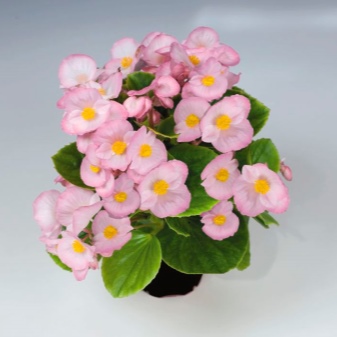
Peculiarities
Begonia is an annual or perennial flower native to the begonia family. Growing begonias from seeds on your own takes a lot of work and constant monitoring. With the help of seeds, you can get an ever-flowering and decorative variety. It is also quite possible to grow tuberous begonias, but this will take a long time. For the result to be successful, you need to select reliable planting material, know exactly when to plant seeds, and follow agrotechnical rules.
There are several types of begonias, for example, tuberous large-flowered "Camellia" (red).

It can bloom all summer and autumn. A strong one is able to appear from seeds, healthy flower "Chanson"... Such begonia can be used to decorate rooms and landscaping balconies, windows, terraces. Begonia "Variation purple" can bloom most of the season and endure unfavorable weather. I must say that absolutely all begonia flowers look beautiful.
When is the best time to plant?
In order for the reproduction of the flower to continue throughout the season, you can use the seedling method. With him, at home, they sow seeds into the soil and wait until sprouts appear.
Sowing usually lasts from the end of January and can continue until April. The correct time is calculated depending on the characteristics of the development cycle of the begonia. In order for the flower to bloom early, it is recommended to plant the seeds in the winter. At this moment, the plant will actively develop roots, and it will be able to adapt to new conditions.
If you sow the ever-flowering begonia early, then by the time of transplanting the seedlings will become overgrown. Such plants will be difficult to take root, and will lose their decorative qualities. If the flowering time comes very early, then the number of flowers will be reduced. Therefore, it is better to sow such begonia in February.
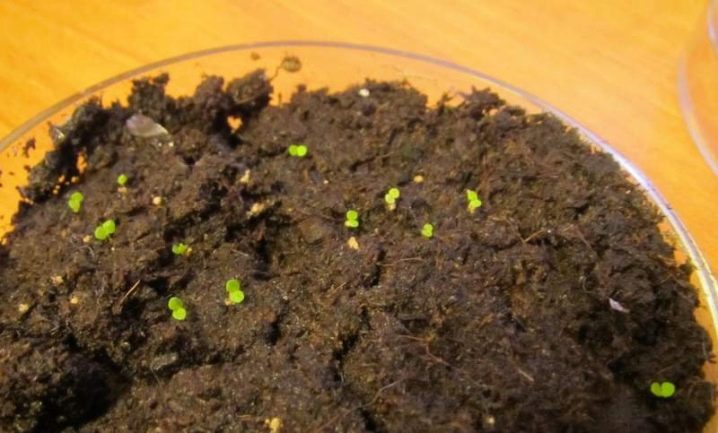
The seeds of the tuberous flower should be planted even earlier, until mid-January comes. Then the plant will have leaves and buds.
If all sowing dates are observed, the tubers will develop normally and reach a diameter of about 3.2 centimeters.
How to choose seeds?
Before planting seeds at home, it is important to understand what kind of seed you need. In order for begonia to grow beautiful and healthy, you need to select specimens that are reliable and good for sowing. There are several points to consider when choosing.
- Shelf life. You need to choose fresh planting material collected this year.
- The size. It is more comfortable to plant granulated seeds in peat tablets. They can have a hard shell of nutrients and this contributes to their larger size. Simple grains have small volumes, so they need to be sown in special containers or seedling boxes.
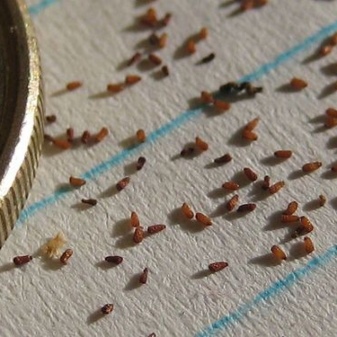
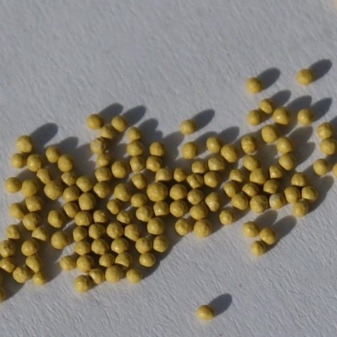
Preparation
To get healthy begonias from seeds, you need to prepare all the necessary materials. The first step is to select the correct seed container.The main requirements are that it must not be too deep, and must also have a compact size. Available as seed pots:
- utensils for sowing seedlings, which are sold in a garden store;
- wooden boxes with low sides;
- peat tray;
- silicone molds for cakes.
Now you need to pick up the soil. Choose soil that will have a good effect on begonia development. For this flower, it is better to purchase slightly acidic or neutral soil.

You can buy such a primer in a store or you can make it yourself. To do this, mix the following components:
- leafy land obtained as a result of rotting a large number of leaves - ½ part;
- peat - ¼ part;
- sand is also ¼.
The prepared soil mass must be sieved using an ordinary sieve - it will help remove excess lumps. Now you can pour the prepared mixture into the planting pots.
If you don't want to make soil for begonias, or you don't have enough time to make it, you can use peat tablets equipped with a net for growing flowers. The nutrients in the pills work well for the flowers to grow healthy. But such a soil must always be watered, as the soil can dry out quickly. If the soil is not moistened, the flower seeds will not be able to survive.
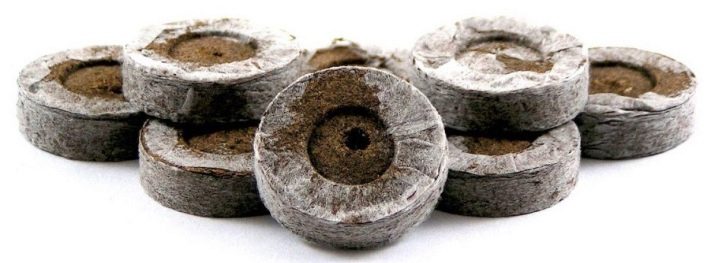
Florists highlight another requirement for the preparation of begonia cultivation, and this is the disinfection and disinfection of the planting material. To disinfect future flowers, begonia seeds must be treated with a weak solution of potassium permanganate. Many also recommend pouring a solution over the soil or calcining it. Thus, you will be able to take care of the prevention of pests and diseases in advance.
Landing
It is quite possible to grow begonia using the seedling method. Before planting granular flower seeds, you need to know all the features of this process.
- Peat tablets should be taken, placed in a tray with liquid, and left to soak.
- Next, the seeds must be spread out on the surface of the tablet and sprayed with liquid.
- A film or glass must be attached to the top of the container. If you need to water or ventilate the seeds, then the shelter is removed for a while.
- You need to water the seeds through the pallet so that the peat tablets cannot dry out.

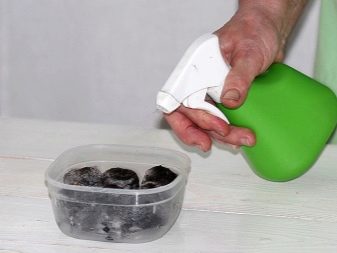
This option for planting begonias has a certain disadvantage - usually flower seeds germinate for a long time.
In addition, it should be remembered that not all seeds will germinate, and therefore purchase additional planting material and peat tablets for insurance.
If you are planting not granular, but simple grains, then they should be placed in a pot with light soil. The day before planting, the soil should be thoroughly watered. To facilitate the process, the grains will need to be mixed with sand and spread in a small layer on the soil. Then you need to cover this pot with glass or film, and put it in a warmed and not too dark place, where a temperature of at least 25 degrees Celsius can be maintained. With this method, the seeds will germinate after 11-26 days.
The emerging begonia sprouts are small, thin and hard to see. To properly develop new "pets", you need constant watering. But this process should be carried out carefully, experts advise using a syringe or moisten the bottom of the pallet. The container in which the flower grows must be constantly opened in order to ventilate it and remove condensation. It is necessary to illuminate the future flower well, but at the same time, be sure to make sure that the direct rays of the sun do not fall on the sprouts (at noon, the seedlings should be slightly shaded). If the light days are short, then artificial light will have to be used for seedlings.

As soon as the shoots sprout, you will need to add an admixture to the soil for decorative deciduous flowers. After studying the instructions for preparing the fertilizer, make a solution with a dose 3 or 4 times less than the recommended one. As soon as the seedlings get stronger, the soil will need to be loosened from time to time. The shelter is gradually removed so that the begonia can grow indoors. The main thing is to keep an eye on the leaves during this period. If the leaves fall, then cover the pot with seedlings. The soil should always be moist, but not soggy. If there is too much water, then a white bloom will appear on the seedlings, and the root system will begin to rot.
Care advice
If you need to transplant seedlings, then it is better to do this at the end of May, when the flowers have already become well-formed. In order not to damage the fragile root system and soft shoots, it is necessary to transplant the flowers using the transshipment method.
The soil for flowers must be purchased light and loose, it must contain good nutrients. As soon as the transplanting process is completed, begonias are immediately watered correctly and top dressing is regularly added. For irrigation, you need to use warm water, which has been infused or has been filtered. In the summer, the flowers are watered abundantly, but they cannot be overfilled either. Plants need to be irrigated every 4 days. If the weather is too hot and the soil dries out quickly, the flowers need to be moistened even more often. Excess water that accumulates in the pan must be drained after half an hour or an hour.
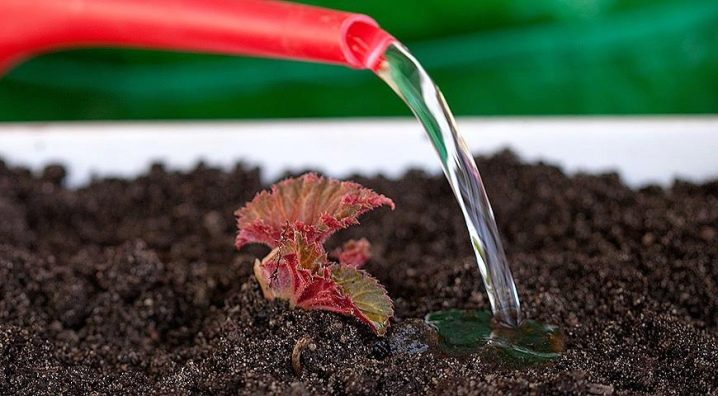
In autumn, flowers should be watered rarely, and when winter comes, the supply of liquid is completely limited. Top dressing should be added to the flowers at the moment when the buds are laid. Liquid complex fertilizers must be provided once every 15 days. As soon as flowering is over, feeding will need to be stopped. In winter, fertilizer cannot be applied at all. However, in winter, do not forget to spray the plant - air dry from heating does not have a very good effect on its well-being.
When does a flower sprout appear?
If begonias were planted from December to March, then the first shoots begin to appear 14 days after sowing. As soon as fresh seedlings are slightly stronger, they must be dived. Remember that begonia will not always be able to flower in the first year of life. It also happens that sprouts can appear faster - on the 6-8th day, but most often you have to wait for shoots for three weeks. As soon as the sprouts have appeared, you need to make sure that the temperature is about 21-23 degrees.
Important: even if the sprouts appeared very quickly, the seedlings may freeze in their development for a while. This is a normal condition, you just need to wait a little while the plants adapt to the new conditions and grow actively again.
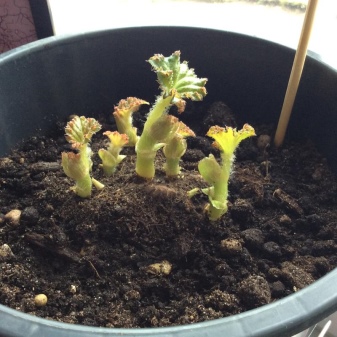
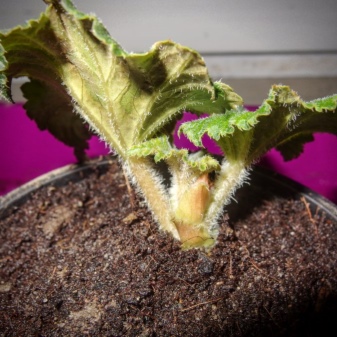
Transfer to a permanent place
If the seedlings are transplanted to a permanent place, then the transplant should be carried out from the beginning of June. The following general rules will help in this process.
- The upper side of the tuber should not be deepened; it should look slightly out of the ground.
- Before the plant is planted, it is necessary to pour fertilizers, which include potassium and phosphorus, and thoroughly water the begonia with water.
- Remove the plant from the pot carefully so as not to damage the root system or stems.
- The distance between tall plants should be 36 centimeters. If the begonia is ampelous, then a distance of 11 centimeters is enough. For a hybrid variety, for example, "Griffin", you need a distance of 26 centimeters.
- It is necessary to transplant begonias into bright and open areas. Where there is a lot of shade, flowers will not bloom.
- Transplant the flowers into light, slightly acidic, nutrient-rich soil. Before you start landing, you need to dig up the soil thoroughly.
- The begonia root should be developed by the time of transplantation, and can be 21 centimeters long.
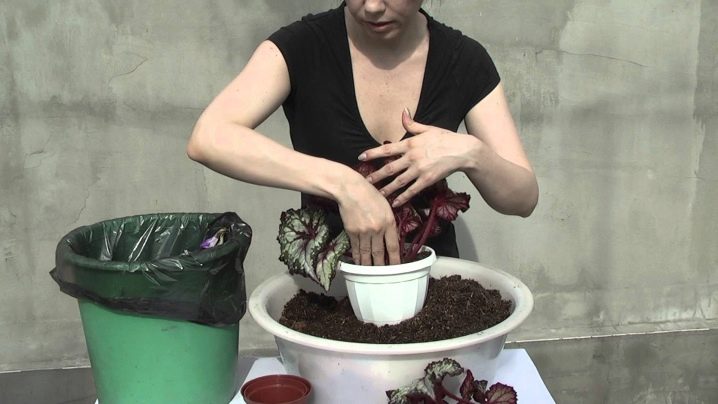
Possible problems
When growing begonias at home, some difficulties may arise, let's dwell on them in more detail.
- If you water the flowers during a hot time of the day, the leaves can get burned. Therefore, it is recommended to water the plants in the evening or early in the morning.
- If there is not enough light, moisture and heat, the begonia will begin to stretch, losing its aesthetic appearance.
- When the flowers dry out, the leaves will be dark, and the begonia itself will not bloom.
- The pale shade of the leaves is a consequence of the fact that you exposed the flower to the scorching rays of the sun.
When growing begonias from seeds, diseases such as root rot and powdery mildew should not be discounted. In this case, you need to ventilate the room and not too moisten the soil. You can treat sick begonia with fungicides, and a soap solution helps well. With advanced forms of the disease, it is better to get rid of the flower before the disease spreads to neighboring plants. For aphids and spider mites, flowers must be treated with insecticides.
It is also worth noting that flower seeds do not always sprout. This means that there was a lack or excess of moisture and heat for them. If no shoots appear within 21 days, then sowing must be repeated.
Thus, seed begonia can be grown independently, at home. The main thing is to follow all the planting rules and provide the flower with proper care. Only in this case, you can expect a beautiful and long-term flowering of the domestic “pet”.
The little tricks of growing begonias from seeds are presented in the next video.































The comment was sent successfully.